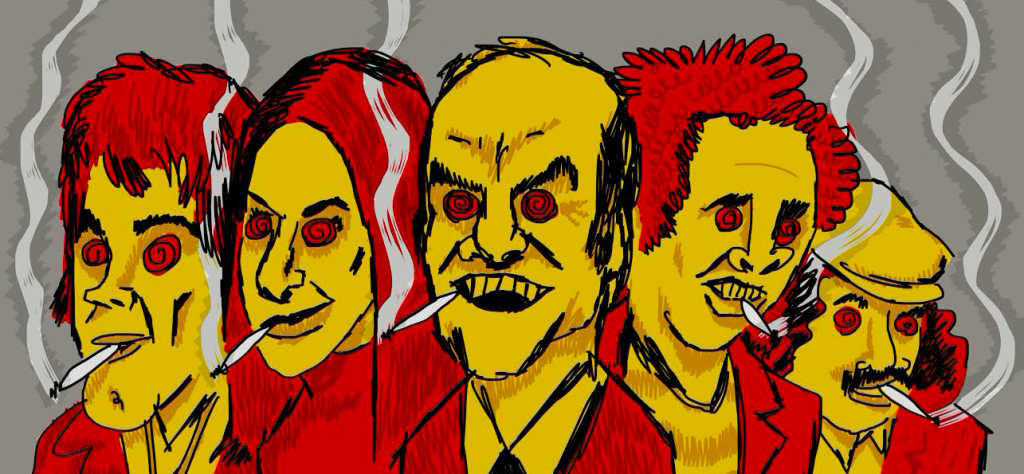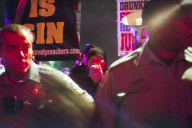The Left’s only hope? Hostile takeover.
This article appears in Blunderbuss Magazine’s forthcoming print edition.
Subscriptions are available on our Patreon page.
As the nation prepares to choose between a neoliberal warlord and a racist Cheeto for president, it’s fair to wonder what, if anything, is next for the American Left.
While the centrist authoritarians of the Democratic Party would rather you take their immense power and political virtue as a given, it seems as crucial a time as any to ask how social democrats and those leftwards are supposed to enact “real change” when “the system is rigged” and neither major party is willing to oppose unfettered capital in any meaningful way.

Here’s how: The Democratic Party must be destroyed. And by destroyed, I mean punctured, scooped out, and worn by the Left like Buffalo Bill from Silence of the Lambs wore his woman suit. Goodbye, Clintons. I’m crying over you.
This will hardly be a walk in the park, and must be enacted in concert with a number of extra-electoral tactics. But I’ve arrived at this position after considering and discarding a slew of shittier options, including:
1.) Throw all our energy behind electing Hillary Clinton in the hopes that she’ll throw us a bone
Certain naïfs believe that if we help the Democratic Party (henceforth known as “the Party”) win an election it’s almost certainly going to win anyway, it will return the favor and prioritize those mildly progressive reforms it pays lip service to every election year. (Reforms which Clinton and the DNC are said to have fought mightily to adopt as few of as possible in exchange for Bernie Sanders’ endorsement.) I’d direct those to whom this tactic’s absurdity is not self-evident to recall the presidential campaign of Clinton I, when he promised civil rights, jobs for the middle class, and universal healthcare and gave us a gutted welfare state, mass incarceration, and the labor-opposed trade deal known as NAFTA.1 The “universal healthcare” bit was bungled largely by Clinton II, who, contrary to popular belief, never attempted to implement a single-payer system, but a tangled plan for “managed competition” that she arrogantly tried to push through Congress despite having little support from either side of the aisle. Liberals thought it an overly complicated and insufficient substitute for single-payer; conservatives bristled at any attempt to regulate the industry.
Clinton II herself has owned her centrism to varying degrees over the course of her career. At times she has identified as a progressive, others a moderate. (If you can be both things at once, even the weak label of “progressive” has lost all meaning.) In a recently leaked closed-door speech to Goldman Sachs, she said she sees herself as occupying “the center-left to the center-right.” While she’s recently ratcheted up her claims to progressivism in an effort to woo recalcitrant millennials, who voted 80-20 against her in favor of a socialist in the primary, leaked audio from a private meeting with campaign donors tells a different tale.
In these remarks, she set up a false equivalency between those who want a national registry of Muslims and a cartoon wall on the Mexican border on the one hand, and “free education, free healthcare” on the other, as if wanting the same access to education and healthcare as the rest of the developed world is the left equivalent of Trump’s pathological xenophobia.
While Clinton II is usually careful to excuse her fiscal conservatism as mere pragmatism (including later in this very speech), she showed her true colors in this moment and has long opposed broadly popular entitlements on grounds, informed by her austere Methodist upbringing, that wage labor ennobles the poor, and that people do not deserve food and shelter by virtue of their mere humanity.2 She is not just overly concerned with wooing the right to win elections, she is uninterested in and incapable of making a public case for even weak social democracy. The difference is not one of feasibility, but ideology.
Given what we’ve seen so far, the Left helping a New Democrat get elected in the hopes she’ll rethink her views on austerity is like a frog helping a scorpion across the river in the hopes it’ll rethink its policy of mutually assured drowning. Keep dreaming.
2.) Mount a successful third party challenge
To look at the behavior of Clinton abstainers at the DNC in Philly, one might almost believe this is an option. I watched Green Party candidate Jill Stein welcome disappointed Sanders supporters under her skirts at a rally in FDR Park as the heavens split open as if to accent the moment’s cracked melodrama. “Vote for the greater good, not the lesser evil!” she crowed, as the next generation of hippies danced with hoops in the rain. A few days later at a panel put on by Socialist Convergence, I watched Stein get up and say basically nothing to uproarious applause. I watched professional firebrand and Christian socialist Chris Hedges get similarly cheered after he tore Sanders a new asshole for declining to walk out of the convention and embark on a kamikaze mission to “build a third party movement.” Then I watched a Sanders staffer named Lev Hirschhorn—a self-identified leftist—get up and say the Democratic Party cannot be reformed, but its machinery can be taken over by socialists like it almost was this time, and a smattering of assholes booed him. We’ll never get socialism at this rate, I thought.
Back in reality, though, there are numerous tough-to-surmount barriers to third party politics at anything but the most local level. If we’re talking about the presidency, the winner-take-all electoral college nearly guarantees they won’t ever win, and that’s if they win the uphill battle to get on state ballots. Third party folks are not allowed into the debates unless they get 15% in at least five reputable polls, which is hard to do when they’re largely ignored by the mainstream media and most polls don’t even ask about them. (Right-populist billionaire Ross Perot was the last to reach this bar in 1992, largely on the strength of his chart-laden, self-funded campaign infomercials.) . They are not taken seriously by anyone, which tends to attract protest candidates who know in their hearts they could not, by any stretch of the imagination, serve as president. The problem becomes self-fulfilling: who wants to join a party that can’t ever win? Nobody writes the detailed policy proposals and creates the political infrastructure that are a requirement for being “taken seriously” by the media. Even more serious candidates like Ralph Nader get crucified and scapegoated by major party elites unwilling to take responsibility for their own failures.
Either due to their association with said presidential candidates, or because the best would-be candidates have chosen non-electoral paths to enacting their politics, similar problems plague those further down the ballot. There have been a handful of Independents elected to Congress in the recent past, but “(I)” is not a party—it is the absence of one. “(I)” has no machinery for raising money, for getting out the vote, or for muscling its way into the political process.
Any kind of socialist party would lack the large donors of the other two for obvious reasons. And even though Sanders showed the power of the almighty $27 this past go around, this might have been impossible without piggybacking on the Party’s massive campaign infrastructure. Historically, independents caucus with one of the two parties or risk being left out of the decision-making. A third party has not mounted an effective challenge to the other two since 1860 when the Republican Party rose to power and elected Abraham Lincoln as the Whig Party fell apart. The Populist Party and Bull Moose Party also made moves in the late 19th and early 20th century. But since then, things have hardened into a binary that is all but impossible to break. And those in a position to change the rules are generally “D” or “R,” hence have little motivation to do so. We’ve had no third-party moments since, just periods of the two-party system realigning, because a two-party system is baked into the structure of American government.
The most recent historical analogy for what Hedges et al are proposing came when the Progressive Party split from the Democratic Party in 1946 and ran former FDR VP Henry Wallace for president. He lost the 1948 election to Harry Truman, garnering just 2.4% of the vote.
Wallace’s campaign did measurably help a single down-ballot Progressive Party candidate, Vito Marcantonio, a communist sympathizer who served seven terms as the most left-wing member of the House of Representatives, representing East Harlem. Similarly, Socialist Alternative has thus far succeeded in electing a single socialist, the India-born Kshama Sawant, to Seattle City Council, and they came close to electing a candidate in Minneapolis. I don’t mean to minimize this victory and near-victory, but it would not be wise to hang all our hopes on such parties.
3.) Popular revolution
Do I even need to waste much of my word count on this? It would require mass defections from America’s armed-to-the-teeth military and militarized police force. The far right has considerably more guns than the Left, and look what’s happened at Ruby Ridge, Oklahoma City, and Burns, Oregon when they’ve tried it. Conversely, popular revolution could take the form of massive strikes and demonstrations, but it didn’t happen in the Great Depression, with the rise of unionization and mass labor organizations like the CIO. It didn’t happen in the 60s and 70s during a supposed cultural revolution, a massive wave of wildcat strikes, war protests,and popular resistance to capitalism and imperialism. It didn’t happen in the last recession or rise out of Occupy. And it’s not going to happen now with a workforce that’s just 12% unionized and barely conscious as a class-in-itself, let alone a class-for-itself. Mass revolt will only happen in America if some sort of crisis comes along that upends society enough to afflict the comfortable many. Then again, many experts believe it will only be a few decades until ecological crisis sets in, so maybe we can revisit this one soon.
Which brings us to…
4.) Hostile takeover
We are living in times of great potential for realignment. While the leftmost of the serious presidential candidates has a consistent record of economic centrism, and center-left figures like Elizabeth Warren represent the Democratic Party’s furthest accepted fringe, large numbers of Americans—many of them young, disillusioned, and reluctant to settle for the current options—support policies far more socialist than the token Sanders-lite provisions in the 2016 platform (which, if history is any indication, Clinton has little intention of honoring). For instance, a recent Gallup poll found 58% of Americans want to replace the demonstrably insufficient Affordable Care Act with a federally funded system that provides healthcare to all, as a right. A full 73% of Democrats polled favored this approach as well as 41% of Republicans. If all of those people had voted in the Democratic primary (and/or had been allowed to), Sanders would be on his way to the White House by now, and the Left would be on its way to unseating Democratic incumbents across the land like the Tea Party did to those moderate Republican cucks.
Unlike third party challenges, there are recent-ish precedents for realignment within the Democratic Party, like the nomination of George McGovern in 1972, which carried with it one of the most progressive platforms in recent history, bombastic statements about the current one notwithstanding. While McGovern was initially an outsider candidate heavily favored to lose to Ted Kennedy, with his Clinton-esque level of name recognition, his chances increased after Kennedy’s infamous Chappaquiddick incident sidelined him from the race. After that, the frontrunner became Edmund Muskie, a center-left technocrat who was Hubert Humphrey’s losing-mate in 1968 and would go on to serve as Secretary of State under Jimmy Carter.
Politically, McGovern fell slightly to the left of Bernie Sanders, but this only made him a liberal Democrat back then, not a democratic socialist. He called for an end to the Vietnam War, as well as an across-the-board 37% reduction in defense spending over three years. (The better to pay for the other reforms he wanted.) He advocated for the rights of organized labor, as well as various programs designed to reduce economic inequality, like a $1,000/year (worth $6,207 today) “demogrant,” or negative tax, that would provide a financial floor under which the poorest Americans could not fall, and which would replace some of the bureaucracy of the welfare state. This idea enjoyed support not only from liberal Democrats, but also from economist and conservative icon Milton Friedman and—in a showing of how far right Democrats have allowed the political spectrum to shift since then—Richard Nixon.
In addition to decrying imperial warfare and wealth inequality, McGovern was progressive on social issues, and stood in support of civil rights, women’s rights, a relaxation of drug laws, and the Equal Rights Amendment. In 1972, an anonymous senator remarked to journalist Robert Novak, “The people don’t know McGovern is for amnesty, abortion and legalization of pot. Once middle America—Catholic middle America, in particular—finds this out, he’s dead.” That stuck, and he was thereafter smeared by his primary opponents as the candidate of “amnesty, abortion, and acid.” (Novak revealed on his deathbed that the anonymous senator was none other than Thomas Eagleton, the man who would become McGovern’s less-than-stellar running mate.)
Amnesty, abortion, and acid must have sounded good to some people, because McGovern rode a number of grassroots movements to become a strong contender for the nomination. While the old Dixiecrats of the South favored the white supremacist George Wallace by large margins, McGovern was able to woo a large number of blue-collar workers in the North with his populist, pro-labor economic program. Like Sanders, he capitalized on widespread anger that Wall Street and the wealthy were getting away with murder while the middle class continued to struggle and the poor got poorer. He also benefitted from an emerging coalition of historically marginalized groups: women, minorities, and LGBT people.
A number of celebrities including Barbra Streisand, Simon and Garfunkel, and Warren Beatty jumped on McGovern’s bandwagon, helping him raise money and get out the youth vote. (Yes, those people were cool once.) He relied on a large network of small donors, with the average donation falling under $30. At the DNC, he overcame a “Stop McGovern” campaign on the part of the party establishment with the help of, among others, an Illinois delegation led by Chicago Alderman William S. Singer and the Reverend Jesse Jackson that successfully challenged the political machine controlled by Chicago Mayor Richard J. Daley.
Unfortunately, McGovern’s campaign fell apart after the nomination, partly due to the smears his fellow Democrats launched at him during the primary, partly due to the conservative running mate he chose and then fired after said running mate’s undergoing electroshock therapy was revealed (a bad look, to be sure), and partly due to his inexperience as a campaigner.

In a warning of white working class abandonment to come, McGovern was the first Democrat not to be endorsed by the AFL-CIO since the labor umbrella’s inception. As we now know, this became a negative feedback loop whereby the Democratic Party abandoned these folks in return, driving them even further into the arms of the Republicans.
McGovern was also up against a popular incumbent during what were regarded by most as economic boom years. (So, too, was liberal Democrat Walter Mondale, who lost terribly to Ronald Reagan in 1984.) While McGovern favored a protectionist approach to trade and was wary of credit, Nixon had been participating in the globalization of capitalism and implementing Keynesian fiscal stimulus programs, creating a bubble of growth. A large plank of McGovern’s platform was opposition to the Vietnam War, which Nixon appeared to be making good on his promise to end while covertly and illegally bombing Cambodia.
He ended up losing every state except Massachusetts and Washington, D.C. (which is not technically a state) to Nixon. But this was not, as New Democrats like to pretend now, because he was “too liberal,” at least not in any analogous way to the social conditions of today.
During the 2016 presidential primary, many a member of the Democratic Party elite invoked the specter of McGovern as a reason they must stay as close to the center as possible if they wanted to “win.” In the same speech cited earlier, Clinton II spoke smugly of how she’d worked for McGovern, and how terribly he’d lost, holding him up as an example of why that pie-in-the-sky stuff she calls “free education, free healthcare” is never going to be politically feasible. This is a fallacy that completely ignores all the things that are different now.
What Clinton II neglected to mention, probably because she supports them, was that the identity politics the mainstream now takes for granted proved far more fatal to McGovern than New Deal social democratic reforms, which even Nixon expressed qualified support for at the time. White people are soon to be a minority in the U.S., a lot of racists and sexists who were alive in 1972 are dead now, and one can hardly imagine an out and proud white supremacist like George Wallace getting 23% of the vote in a Democratic primary today. There’s no popular incumbent running, we are hardly living in times of economic prosperity, and Americans’ taste for empire is waning. Organized labor has gone back to riding the Democrats’ coattails, at least for now.
In another major contrast to 1972, folks are finally wary of the imaginary money that drove the last cycle of accumulation… you know, the one that crash-landed in 2007 with the subprime mortgage crisis. Given these shifts in conditions and demographics, there’s no reason a left-populist like Bernie Sanders could not win a presidential election and help numerous down-balloters take the House and Senate in the process.
Indeed, from Greece’s Syriza Party to England’s Labour Party leader Jeremy Corbyn, it seems left-populism, rather than Clinton-style neoliberalism, is the only approach that has any hope of defeating rising right-populist movements around the world like UKIP, the Golden Dawn, and the National Front. You cannot win back the white working class (and its middle and upper class fetishists) from a right-populist like Donald Trump by calling them “deplorables” and promising them more austerity, and you certainly can’t do it by telling them, as National Review writer Kevin Williamson did, that their communities deserve to die. You do it by exposing Trump’s phony populism, and recognizing their vicious xenophobia as a symptom, not a cause, of their anger and hopelessness.
This also seems as good a time as any to mention Barry Goldwater, that “McGovern of the right” who lost terribly to centrist Democrat LBJ in 1964. But rather than tack to the middle in response to their loss like the Democrats tend to do, the reactionaries of the Republican Party dug in for a ‘long march through the institutions’, which paid off with the eight-year reign of Ronald Reagan, during which the New Deal welfare state began to be dismantled, and the lasting rightwards shift of American politics, both projects enthusiastically furthered by Clinton I. Either the modern Democratic Party is worse at long-term strategy than the party of creationists, or it’s not as liberal as it pretends to be… neither of which makes a particularly strong case for its continued existence as-is.
In many ways, the social forces have reversed themselves such that the primaries themselves, and not the general elections, pose the biggest obstacle to realignment. While the coalition that nominated McGovern was comprised of northern labor, youth movements, and minority groups, the one that nominated Hillary Clinton consists of Silicon Valley, Hollywood, Wall Street, transnational U.S. firms, bourgeois feminists, corporate media, the professional-managerial class, the black political class, and the DNC itself.
These groups are a formidable bunch who will fight tooth and nail to make sure nobody is able to wrest power away from them. Identity politics, in particular, have been divorced from their radical, class-conscious origins and used as an ugly cudgel against left-challengers. (See also: “Not everyone who hates Hillary Clinton is a sexist.”) But recent data holds seeds of hope. The single biggest demographic divider in the Democratic primary was age, with the 74-year-old Sanders beating Clinton among under-30 voters by margins of 3-1 and 4-1. While race and gender mediated the results somewhat, he still won simple majorities among Latino, female, and black under-30s. And those voters will soon be over 30, replaced by yet more children of the Great Recession and uneven “recovery.” There’s no telling what kind of power this bloc could wield if their turnout rivaled that of their parents and grandparents.
Of course, given Sanders’ margin of winning among black youth (narrow) versus white youth (wide), the question remains: How can socialism earn the black vote, without which there can be no takeover and no realignment?
Born of a different political era, the Sanders campaign took it for granted that minority voters would associate redistributive economic policies with those that mitigate identity-based oppression. (The Black Panther Party of his political youth—the ones who popularized the phrase “black is beautiful”—explicitly hoped to unite workers of all races to expropriate the ruling class.) But ever since Dr. King was assassinated on the eve of his Poor People’s March on Washington, the neoliberal establishment has worked to separate race from class, pretending minorities’ disproportionate share of economic hardship is due purely to the racial animus of individuals rather than abusive economic policy. The New Democrats pretend to hate the white working class for their backwardness, but it’s really because their failure to thrive proves there must be more to the story. That even if you “break down barriers,” the Horatio Alger narrative is a dirty lie used by capitalist pigs to fuck you.
The Clintons have chosen their black allies wisely, shunning radicals in favor of those willing to sacrifice broad, class-based reforms in exchange for access to the halls of power, via which they hope to enact at least some incremental relief for their communities.4 Perhaps feeling defeated from the get-go, the Sanders campaign did not do nearly enough outreach in these communities. It did not work nearly as hard to prove race and class are connected in a shitty Venn diagram of oppression as the Party elite has worked to separate them. This mistake cannot be repeated.
But there is a different wind blowing. Contrast the left-neoliberal policies of the Obama administration with the radical platform set forth by the Movement for Black Lives, which includes redistribution as a major goal. Rather than focus solely on “systemic” racism—a nebulous term favored by Clinton that falls short of fully explaining the violence perpetrated by minority cops, or against poor whites—the M4BL connects police violence against marginalized people to welfare “reform,” mass incarceration, and imperial warfare around the world. Black Lives Matter does not just want a more proportionally appropriate number of blacks, Latinos, Native Americans, Asians, and whites to be murdered by the police. It wants to reduce state violence across the board, and that includes economic violence. It was racism that enabled the bipartisan dismantling of the welfare state, so it stands to reason that anti-racism might yet bring it back.5 It’s not enough to have a proportionate rainbow of faces at the top of the old hierarchy. We need to tear the whole system down
More hope: As summarized at Jacobin by Matt Karp, black Democrats support redistributive economic policies at substantially higher rates than their white counterparts. When it comes to actual policy, social democrats have more in common than not with the desires of African-American voters. Try as the Clintonites might to make it seem otherwise, these questions are hardly a “white issue,” nor are they one of “brocialism.” Cornel West, who manages to hold both class and identity politics simultaneously, recently did a star turn on the Democratic platform committee and continues to mentor the younger generation of black radicals.6
Black activists have been at the forefront of most populist struggles in America, from abolition, to Civil Rights, to the anti-war movement. American feminism, too, was born holding tight to labor, with the Lowell mill girls being one of the first groups of American workers to organize and strike. There’s no reason to believe overlapping groups of woman, minority, and LGBT activists will not play a major role in the coming realignment, as they must if it is to succeed.
But none of this happens if the left just falls into line with the Democratic Party, waiting for table scraps that won’t ever fall our way. Nor will the weak chastening of a protest vote (or naive hope of a viable third party) be enough to draw the Party left. Left is a place where it will have to be dragged, and it is our best bet.
As both a prerequisite for, and supplement to, electoral victories at every level of government, the Left will need a swelling of grassroots movements that pressure elected officials and change the prevailing narrative from the one set forth—very effectively, might I add—by corporate media and myopic Tumblr-progressivism, which focuses on the politics of representation to the detriment of everything else. We have already seen some of this with BLM and Fight for $15, and Sanders’ candidacy would not have been possible without Occupy Wall Street. Labor unions are making a comeback through drives to organize industries as disparate as fast food, app-based taxi services, and digital media. Unconventional tactics like worker centers are reappearing, and worker-owned collectives are gaining visibility. A rising international community of young leftists exchanges information and ideas via alternative online media, connecting struggles from Ferguson to New York to Istanbul to Athens. Feminists in India get updates on Chelsea Manning, artists in New York draw the faces of Syria’s all-female militias, and leftists from North America and Europe physically travel to help secular leftist Kurds fight ISIS in revolutionary Rojava.
Given these encouraging trends, it seems at least possible to build a coalition of leftist, and not merely liberal, voters to cast tactical ballots to replace the pandering, out-of-touch cocktail crowd—from city councils to the presidency—with committed fighters who’ll champion reforms that will not just mitigate the worst effects of capitalism, but move us towards a better, more stable, and more democratic system. Only then will we see the “political revolution” of which Sanders spoke, which is really just the start of a new struggle. Only then will we have a Democratic Party that truly represents the interests of the 99%. Only then will we see the kinds of sweeping changes we need to pull ourselves out of this eternally looping reactionary nightmare.
_______________
Notes:
1 As described in Doug Henwood’s My Turn: Hillary Clinton Targets the Presidency, Clinton II had a hand in drafting many of these policies and was reportedly one of the more reactionary voices in her husband’s administration.
2 For a thorough exploration of Clinton I’s racialized, paternalistic attack on welfare, an attack Clinton II touted as a success as recently as 2008, see “Why It Matters That Hillary Clinton Championed Welfare Reform” and “Why Hillary Clinton Doesn’t Deserve the Black Vote,” both at The Nation.
3 This does not mean those living in swing states should not take 10 minutes out of their respective days to cast a tactical vote for Clinton. It’s an easy thing to do, and need not distract us from our overarching goals, which include finding someone to run against her in the 2020 primary. Are you happy now, certain Facebook friends?
4 This process—as well as the trajectory of various black radical movements—is outlined in detail in Keeanga-Yamahtta Taylor’s book From #BlackLivesMatter to Black Liberation.
5 While some, like Professor Adolph Reed, believe modern antiracist politics constitute the left wing of neoliberalism, I’m more inclined to agree with Paul Heideman & Jonah Birch, who argue convincingly at Jacobin that these kinds of politics have great potential to lead activists to a critique of American capitalism.
6 That video of West berating Party elites over their blind support of the Israeli apartheid state is one for the ages and something you should watch if you haven’t.
_______________
Art by Drew Lerman.

















